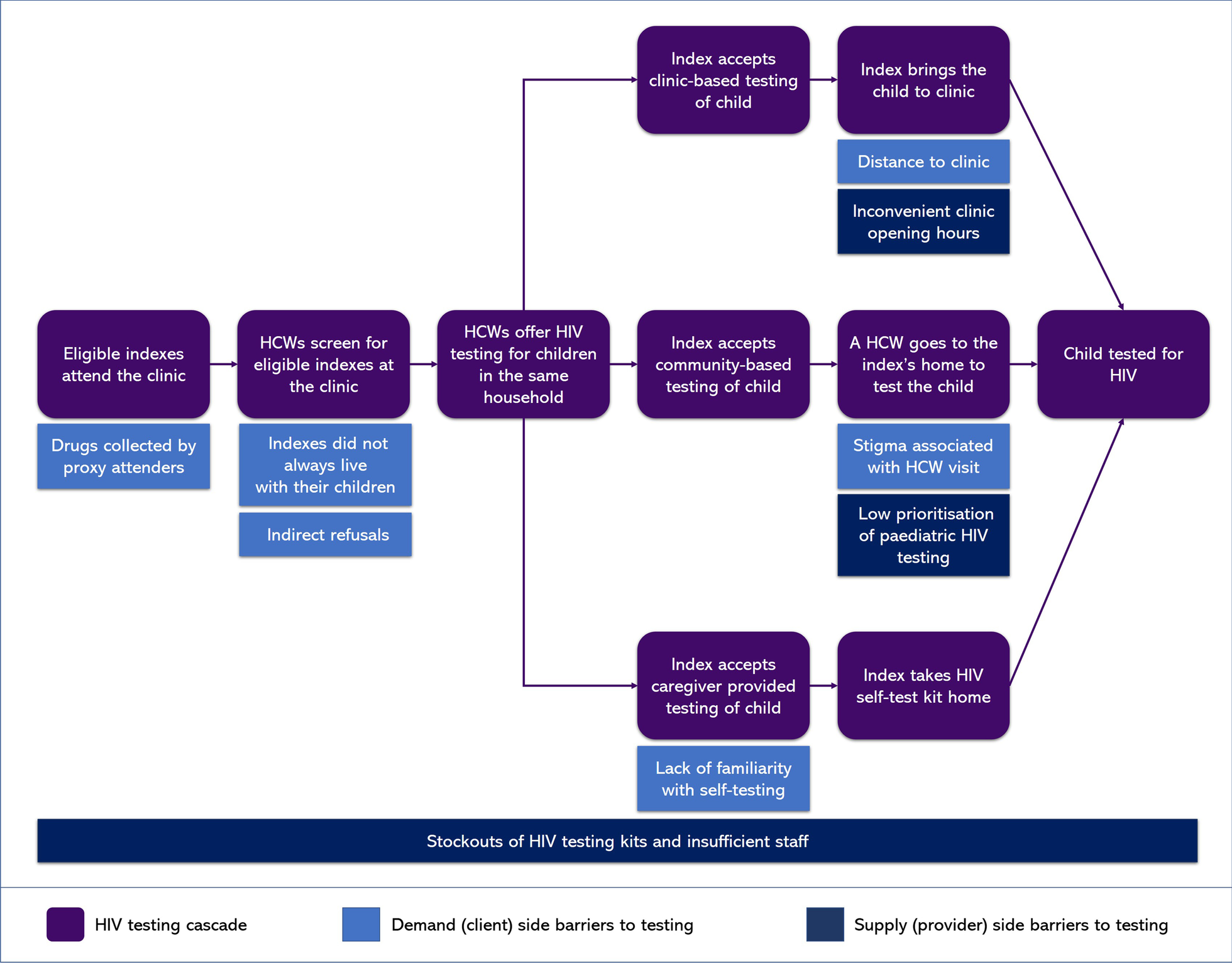Using WhatsApp chats to understand a new approach to HIV testing in children.
Published in Healthcare & Nursing

Improving HIV testing for children and adolescents is vitally important, because children and adolescents experience a disproportionate amount of HIV-related illness and death compared to adults. Although children and adolescents aged up to 19 years old were only 7% of the global population living with HIV in 2021, they represented 17% of HIV-related deaths. This is due, in part, to late diagnosis of HIV.

A new approach to finding undiagnosed children living with HIV, known as index-linked testing, has been recommended by the World Health Organisation to improve diagnosis rates. Index-linked testing involves targeting of HIV testing to children of people living with HIV (known as indexes). This focused approach has the potential to find more children living with HIV and be more cost-effective than blanket testing approaches.
The “Bridging the Gap in HIV Testing and Care for Children in Zimbabwe” (B-GAP) study evaluated index-linked HIV testing for children aged between two and 18 years old at nine primary care clinics, covering both rural and urban areas. People living with HIV in a household with one or more children of unknown HIV status, or with a known HIV negative result more than 6 months ago, were eligible to take part in the study. Those who consented to have children tested could choose either a test at the clinic, a test at home delivered by a community healthcare worker (HCW), or a test at home delivered by a caregiver using an oral HIV self-test. B-GAP provided an opportunity to examine implementation in-depth, so lessons could be learned for future roll-out.
The B-GAP team kept in touch via two long-running WhatsApp chats, one for the whole field team, and the other for the rural areas only. We used those WhatsApp chats, as well as field team logs, meeting minutes, and incident reports, to identify barriers and facilitators to scale-up of index-linked testing. Data from each source was analysed thematically.

The WhatsApp chats deepened our understanding of implementation. In the chats, the team often offered more comprehensive opinions on successes and challenges than in other sources. For example, one chat had detailed discussion on difficulties coordinating with partner organisations who were delivering HIV testing of children in the community. This clarified the underlying reasons why these challenges were occurring, such as differences in aims between the partner organisations and the research team, as well as resource constraints faced by partner organisations. The chats also provided a real-time and dynamic account of events, such as stock-outs of HIV test kits, over time.
However, WhatsApp chats required more effort to analyse than the other sources. As the chats were an informal record, sometimes it was challenging to work out what researchers were referring to in their messages. Unlike with the other sources, the team presumed readers had prior knowledge of what was being discussed, making it difficult for an outsider to follow the conversation. Moreover, sometimes researchers met face-to-face or communicated using other technology, which led to sudden jumps in the topics being covered in the chats.

Nonetheless, through analysing the WhatsApp chats and other sources, we identified a range of challenges to index-linked testing for children. These are illustrated in the flow diagram to the right. Some challenges were recognised barriers to provision of many forms of HIV testing, such as stock-outs of HIV test kits, difficulties reaching clinics, and stigma around HIV. However, we also identified some unexpected challenges, such as indexes sending someone else to the clinic on their behalf, and a lack of familiarity with oral HIV testing, which resulted in low uptake. As index-linked HIV testing for children is used more widely it will be critical to find ways to ensure these challenges can be overcome.
The WhatsApp chats gave us valuable insight into the barriers and facilitators of index-linked HIV testing. It is important to consider newer technologies and social media alongside traditional sources of data to fully capture the complexity of implementation of public health interventions. By doing so, we can more effectively address barriers to delivery of interventions and ultimately improve health outcomes.
Read more about the B-GAP study and its findings in the following publications:
- Delivery of index-linked HIV testing for children: learnings from a qualitative process evaluation of the B-GAP study in Zimbabwe
- Comparison of index-linked HIV testing for children and adolescents in health facility and community settings in Zimbabwe: findings from the interventional B-GAP study
- Addressing the challenges and relational aspects of index-linked HIV testing for children and adolescents: insights from the B-GAP study in Zimbabwe
- Feasibility and Accuracy of HIV Testing of Children by Caregivers Using Oral Mucosal Transudate HIV Tests
Follow the Topic
-
BMC Infectious Diseases

This journal is an open access, peer-reviewed journal that considers articles on all aspects of the prevention, diagnosis and management of infectious and sexually transmitted diseases in humans, as well as related molecular genetics, pathophysiology, and epidemiology.
Related Collections
With Collections, you can get published faster and increase your visibility.
Artificial intelligence in infectious disease management: transforming diagnosis, treatment, and prevention
BMC Infectious Diseases invites submissions for a Collection on Artificial intelligence on infectious disease management.
The advent of artificial intelligence (AI) in healthcare has revolutionized the landscape of infectious disease management. By harnessing the power of machine learning, predictive analytics, and advanced algorithms, AI is poised to transform how we diagnose, treat, and prevent infectious diseases. From rapid identification of pathogens to real-time monitoring of disease outbreaks, AI technologies are increasingly being integrated into public health strategies and clinical practices, offering unprecedented opportunities to enhance patient outcomes and streamline healthcare delivery.
The integration of AI into infectious disease management is crucial for addressing the challenges posed by emerging and re-emerging pathogens, as well as antibiotic resistance. Recent advances in AI-driven diagnostics have shown promise in improving the accuracy and speed of disease detection, while predictive analytics can help forecast outbreaks and inform timely interventions. As these technologies continue to evolve, they hold the potential to significantly enhance our ability to combat infectious diseases on a global scale.
Continued research in this field could lead to groundbreaking developments, such as fully autonomous diagnostic systems that can accurately identify pathogens in real-time, personalized treatment plans tailored to individual patient profiles, and AI systems capable of predicting disease outbreaks before they occur. These advancements could ultimately reshape our approach to infectious disease management, making it more efficient, proactive, and effective.
- AI-driven diagnostics for infectious diseases
- Machine learning applications in healthcare
- Predictive analytics for disease outbreak prediction
- AI in disease prevention strategies
This Collection supports and amplifies research related to SDG 3: Good Health and Well-being.
All manuscripts submitted to this journal, including those submitted to collections and special issues, are assessed in line with our editorial policies and the journal’s peer review process. Reviewers and editors are required to declare competing interests and can be excluded from the peer review process if a competing interest exists.
Publishing Model: Open Access
Deadline: Dec 31, 2025
Infectious diseases in cancer patients
BMC Infectious Diseases invites submissions for a Collection on Infectious diseases in cancer patients.
Cancer patients are particularly vulnerable to infectious diseases due to their immunocompromised status resulting from both the malignancy itself and the aggressive treatments employed in oncology, such as chemotherapy and radiotherapy. Infections can lead to significant morbidity and mortality in this population, complicating cancer management and adversely affecting treatment outcomes. Understanding the mechanisms behind increased susceptibility to infections in cancer patients is crucial for developing effective preventive measures and therapeutic strategies.
Addressing infectious diseases in cancer patients is vital as recent advances in both cancer treatment and infectious disease management have improved patient survival rates but have also led to a more complex interplay between oncological and infectious complications. Vaccination strategies, the use of prophylactic antibiotics, and advances in infection control practices have shown promise in mitigating risks. Furthermore, the emergence of new pathogens and antibiotic resistance underscores the need for ongoing research in this area to ensure optimal care for this vulnerable population.
With continued research, we may see significant advancements in tailored infection prevention strategies, more effective use of immunotherapies to enhance immune responses in cancer patients, and the development of rapid diagnostic tools for identifying infections. Future studies may also lead to improved understanding of the microbiome's role in cancer patient susceptibility to infections, paving the way for novel therapeutic approaches. We invite submissions that explore a wide array of topics within the scope of infectious diseases, including but not limited to:
- Oncology infections in immunocompromised hosts
- Chemotherapy-associated infections and management
- Infection prevention strategies for cancer patients
- The role of microbiome in cancer-related infections
This Collection supports and amplifies research related to SDG 3: Good Health and Well-being.
All manuscripts submitted to this journal, including those submitted to collections and special issues, are assessed in line with our editorial policies and the journal’s peer review process. Reviewers and editors are required to declare competing interests and can be excluded from the peer review process if a competing interest exists.
Publishing Model: Open Access
Deadline: Dec 31, 2025




Please sign in or register for FREE
If you are a registered user on Research Communities by Springer Nature, please sign in